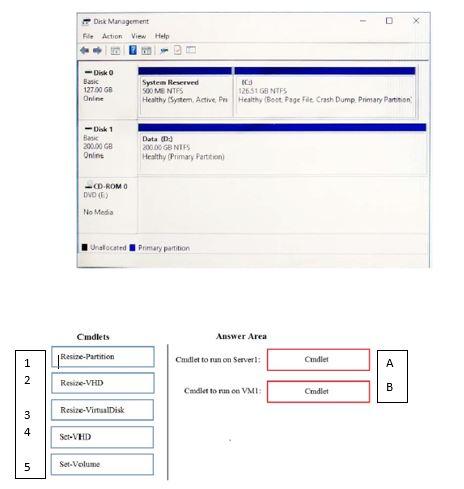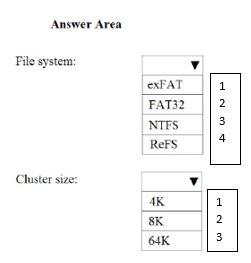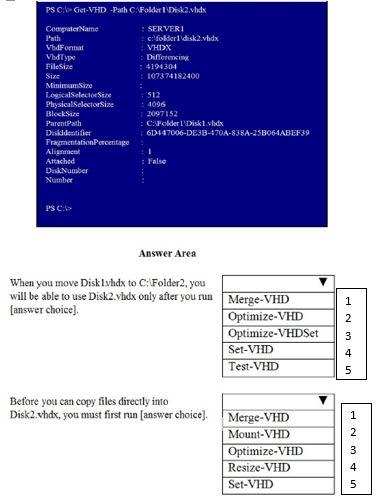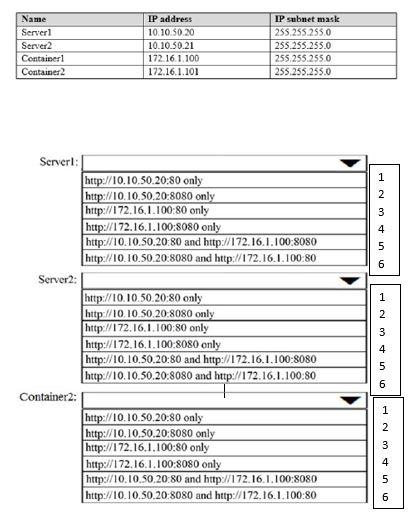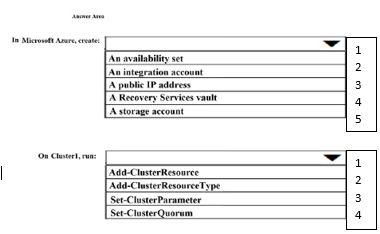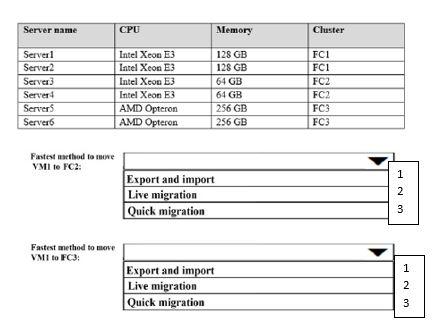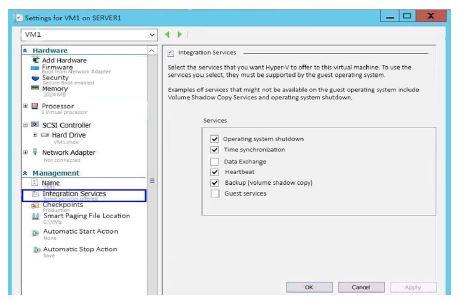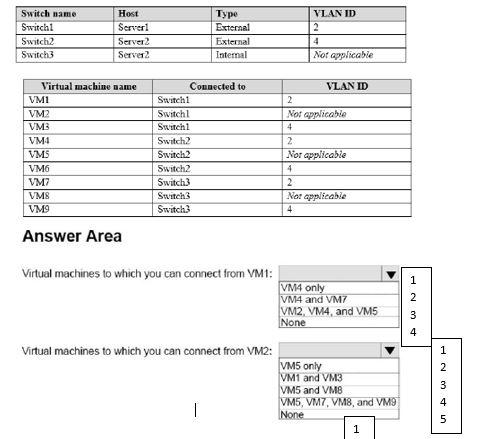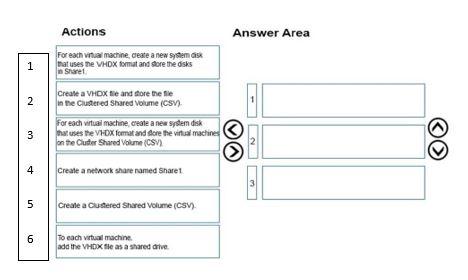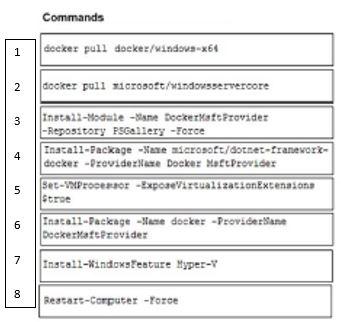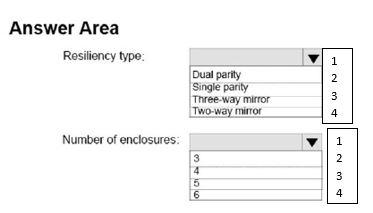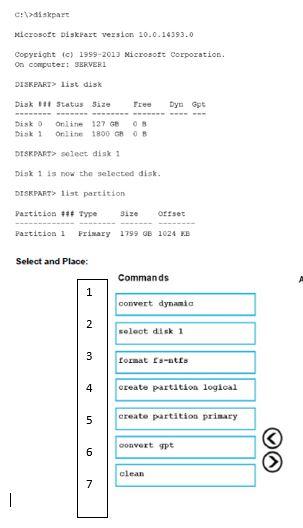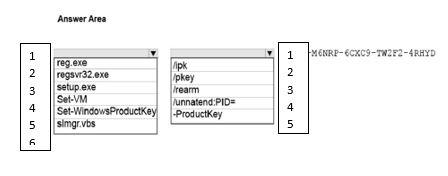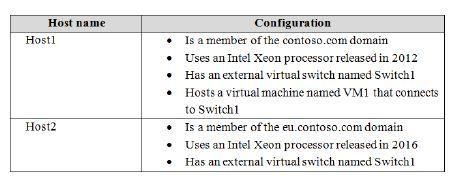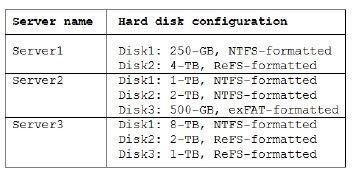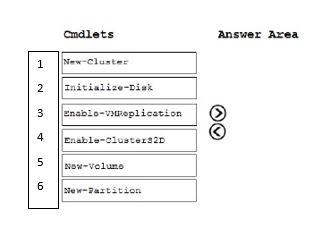MCSA 181 - 240

This quiz tests knowledge on managing Hyper-V on Windows Server 2016, including VM migration, event log filtering, image repair, and disk configuration.
- 1.
You have two Hyper-V hosts named Server1 and Server2 that run Windows Server 2016. The hosts are nodes in failover cluster. A highly available virtual machine named VM1 is running on Server1. You need to move VM1 to Server2 while minimizing downtime. What should you do?
- A.
A. From Windows PowerShell, run Move-ClusterGroup
- B.
B. From Hyper-V Manager, use the Move action.
- C.
C. From Failover Cluster Manager, use the Move Virtual Machine Storage option.
- D.
D. From Windows PowerShell, run Move-VM.
Correct Answer
A. A. From Windows PowerShell, run Move-ClusterGroupExplanation
To minimize downtime while moving the highly available virtual machine VM1 from Server1 to Server2, the appropriate action is to use the Move-ClusterGroup command in Windows PowerShell. This command specifically moves the cluster group, which includes the virtual machine, to the specified node in the failover cluster. By using this command, the virtual machine can be seamlessly migrated to Server2 without causing any significant interruptions or downtime for the users.Rate this question:
-
- 2.
QUESTION 182 You have two Hyper-V hosts named Server1 and Server2 that run Windows Server 2016. Server1 hosts a virtual machine named VM1 that is in a Running state. On Server1, you export VM1 and then you import VM1 on Server2. What is the current state of VM1 on Server2?
- A.
A. Paused
- B.
B. Off
- C.
C. Saved
- D.
D. Running
Correct Answer
C. C. SavedExplanation
When you export a virtual machine, it saves the current state of the virtual machine. Therefore, when you import VM1 on Server2, the current state of VM1 will be saved.Rate this question:
-
- 3.
QUESTION 183 You have a file server named Server1 that runs Windows Server 2016. Object access auditing is configured on Server1. You need to filter the Security event log to show all log entries that relate to a user named User1. What should you do?
- A.
A. Right-click the Security log, and then click Filter Current Log… On the Filter tab, type a value in the User box.
- B.
B. Right-click the Security log, and then click Filter Current Log… On the Filter tab, select a value from the Event sources box.
- C.
C. Right-click the Security log, and then click Create Custom View… On the Filter tab, type a value in the User box.
- D.
D. Right-click the Security log, and then click Filter Current Log… On the XML tab, modify the QueryList entry and set an EventData tag.
Correct Answer
A. A. Right-click the Security log, and then click Filter Current Log… On the Filter tab, type a value in the User box.Explanation
To filter the Security event log to show all log entries that relate to a user named User1, you should right-click the Security log and select "Filter Current Log". Then, on the Filter tab, you should type "User1" in the User box. This will apply a filter to only show log entries that are associated with User1.Rate this question:
-
- 4.
QUESTION 184 HOTSPOT You have a server named Server1 that runs Windows Server 2016. On Server1, you have a custom image of Windows Server 2016 Standard in a file named Image1.wim. The image is mounted to C:\Folder1. You discover corrupted files in the WinSxS folder of the mounted image. From the Windows Server 2016 installation media, you mount an image of Windows Server 2016 Standard from Install.wim to C:\Folder2. You need to repair the corrupted image. Which command should you run? To answer, select the appropriate options in the answer area. NOTE: Each correct selection is worth one point.
- A.
2-A-3
- B.
1-B-4
- C.
3-C-2
- D.
1-D-4
Correct Answer
B. 1-B-4 -
- 5.
QUESTION 185 DRAG DROP You have a Hyper-V host named Server1 that runs Windows Server 2016. Server1 hosts a virtual machine named VM1. VM1 runs Windows Server 2016. VM1 uses a VHD for storage. The disk configuration of VM1 is shown in the exhibit. (Click the Exhibit button.) You need to increase the size of volume D to 400 GB. Which cmdlets should you run on Server1 and VM1? To answer, drag the appropriate cmdlets to the correct servers. Each cmdlet may be used once, more than once, or not at all. You may need to drag the split bar between panes or scroll to view content. NOTE: Each correct selection is worth one point.
- A.
4A-2B
- B.
3B-5A
- C.
2A-1B
- D.
1B-2A
Correct Answer
C. 2A-1B -
- 6.
QUESTION 186 HOTSPOT You have a server named Server1 that runs Windows Server 2016. On Server1, you plan to create a new volume named Volume1. Volume1 will contain image files. You need to identify which file system and which cluster size to configure for Volume1. The solution must ensure that the image files will be compressed by using file system compression. Which file system and cluster size should you identify? To answer, select the appropriate options in the answer area. NOTE: Each correct selection is worth one point.
- A.
3-1
- B.
4-2
- C.
3-2
- D.
1-3
Correct Answer
A. 3-1 -
- 7.
QUESTION 187 You have a server named Server1 that runs Windows Server 2016. The server has an application named App1. App1 writes entries to the Application event log when errors are encountered. The events have IDs of either 111 or 112. You need to restart the service whenever either of these events is logged. What should you do?
- A.
A. From Windows PowerShell, run the Get-SMServerEvent cmdlet and pipe the output to the Start-NetEventSession cmdlet
- B.
B. From Event Viewer, create a subscription that has a filter for the event IDs.
- C.
C. From Task Scheduler, use Create Task to create one task that includes triggers for both event IDs.
- D.
D. From Windows PowerShell, run the Get-Event cmdlet and pipe the output to the Start-NetEventSession cmdlet.
- E.
E. From Performance Monitor, add an Event Trace Session data collector that uses the Microsoft-Windows-Eventlog provider.
- F.
F. From Event Viewer, create a custom that has a filter for the event IDs.
- G.
G. From Windows PowerShell, run the Write-EventLog cmdlet and specify the –EventID parameter and the –Source parameter.
Correct Answer
C. C. From Task Scheduler, use Create Task to create one task that includes triggers for both event IDs.Explanation
Creating a task in Task Scheduler with triggers for both event IDs allows for the automatic restart of the service whenever either event is logged. This task can be scheduled to run at specific intervals or triggered by specific events, ensuring that the service is restarted whenever an error is encountered. This is the most appropriate solution for the given scenario.Rate this question:
-
- 8.
QUESTION 188 HOTSPOT You have a Hyper-V host named Server1 that runs Windows Server 2016. Server1 has a virtual disk file named Disk1.vhdx that contains an installation of Windows Server 2016. You create a virtual disk file named Disk2.vhdx that is configured as shown in the following exhibit. Use the drop-down menus to select the answer choice that completes each statement based on the information presented in the graphic.
- A.
3-1
- B.
1-4
- C.
5-3
- D.
4-2
Correct Answer
D. 4-2 -
- 9.
QUESTION 189 HOTSPOT You have two servers named Server1 and Server2 that run Windows Server 2016. Server1 hosts two containers named Container1 and Container2. The servers and the containers are configured as shown in the following table. Container1 hosts a website on port 8080. You create a port mapping between port 8080 on Container1 and port 80 on Server1. Which URL can you use to access the website from Server1, Server2, and Container2? To answer, select the appropriate options in the answer area. NOTE: Each correct selection is worth one point.
- A.
2-6-1
- B.
4-6-3
- C.
1-3-5
- D.
2-4-6
Correct Answer
A. 2-6-1 -
- 10.
QUESTION 190 HOTSPOT You have a Windows Server 2016 failover cluster named Cluster1. You need to implement Cloud Witness for Cluster 1. What should you do? To answer, select the appropriate options in the answer area. NOTE: Each correct selection is worth one point.
- A.
1-1
- B.
5-4
- C.
2-1
- D.
3-4
Correct Answer
B. 5-4 -
- 11.
QUESTION 191 HOTSPOT Your network contains an Active Directory domain named contoso.com. The domain contains three clusters named FC1, FC2, and FC3. The domain contains servers that run Windows Server 2016. The servers are configured as shown in the following table. Server1 hosts a highly available virtual machine named VM1. You are creating a maintenance plan for the servers, and you are evaluating how to move VM1 to the different clusters. You need to identify the fastest method to move VM1 to FC2 and FC3. Which method should you identify for each cluster? To answer, select the appropriate options in the answer area. NOTE: Each correct selection is worth one point.
- A.
2-3
- B.
1-3
- C.
2-2
- D.
3-3
Correct Answer
A. 2-3 -
- 12.
QUESTION 192 You have a Hyper-V host named Server1 that runs Windows Server 2016. Server1 has ab external virtual switch named Switch1. Server1 hosts a virtual machine named VM1 that runs Windows Server 2016. VM1 has one network adapter. The network adapter connects to Switch1. You need to limit the maximum network bandwidth available to VM1 to 100 Mbps. The solution must limit the bandwidth for VM1 only. Which cmdlet should you run?
- A.
A. Set-NetAdapter
- B.
B. Set-VMNetworkAdapter
- C.
C. Set-VM
- D.
D. Set-NetAdapterVmq
- E.
E. Set-NetworkSwitchPortProperty
Correct Answer
B. B. Set-VMNetworkAdapterExplanation
You should run the Set-VMNetworkAdapter cmdlet to limit the maximum network bandwidth available to VM1 to 100 Mbps. This cmdlet allows you to configure the settings for a virtual network adapter, including bandwidth limits.Rate this question:
-
- 13.
QUESTION 193 You have a Windows Server 2016 failover cluster that contains two servers named Server1 and Server2. The Cluster Service on Server1 fails. You need to identify the cause of the failure. What should you do?
- A.
A. From Windows PowerShell, run the Get-ClusterNode cmdlet.
- B.
B. From Event Viewer, review the Application event log.
- C.
C. From Windows PowerShell, run the Get-ClusterLog cmdlet.
- D.
D. From Event Viewer, review the System event log.
Correct Answer
C. C. From Windows PowerShell, run the Get-ClusterLog cmdlet.Explanation
To identify the cause of the failure in the Windows Server 2016 failover cluster, you can use the Get-ClusterLog cmdlet in Windows PowerShell. This cmdlet retrieves the cluster log files, which contain information about cluster events and errors. By reviewing the cluster log, you can determine the cause of the failure in the Cluster Service on Server1. Reviewing the Application or System event logs in Event Viewer may provide some information, but the Get-ClusterLog cmdlet specifically retrieves the cluster log files for a more detailed analysis.Rate this question:
-
- 14.
QUESTION 194 You have a server named Server1 that is an iSCSI target. You have a server named Server2 that runs Windows Server 2016. Server2 has an iSCSI disk named Disk1 that is hosted on Server1. Disk1 contains one volume that is assigned a drive letter of E. You need to increase the size of Disk1. What should you do?
- A.
A. Run the Resize-IscsiVirtualDisk cmdlet and specify the -ComputerName Server2 parameter.
- B.
B. Run the Resize-IscsiVirtualDisk cmdlet and specify the -ComputerName Server1 parameter.
- C.
C. Run the Resize-Partition cmdlet and specify the -ComputerName Server1 parameter.
- D.
D. Run the Resize- Partition cmdlet and specify the -ComputerName Server2 parameter.
Correct Answer
B. B. Run the Resize-IscsiVirtualDisk cmdlet and specify the -ComputerName Server1 parameter.Explanation
To increase the size of Disk1, you need to run the Resize-IscsiVirtualDisk cmdlet. Since Disk1 is hosted on Server1, you need to specify the -ComputerName Server1 parameter to target the correct server. Therefore, the correct answer is B. Run the Resize-IscsiVirtualDisk cmdlet and specify the -ComputerName Server1 parameter.Rate this question:
-
- 15.
QUESTION 195 Your network contains an Active Directory domain. The domain contains a new file server named Server1 that runs a Server Core installation of Windows Server 2016. Server1 has an ReFS-formatted volume D: and NTFS-formatted volume E: The volumes do not contain any data. You install the Data Deduplication role service on Server1. You need to implement Data Deduplication for volumes on D: and E:. Solution: From Windows PowerShell, you run Format-Volume D: -FileSystem NTFS and Enable-DeDupVolume -Volume D:,E:. Does this meet the goal?
- A.
YES
- B.
NO
Correct Answer
A. YESExplanation
The given solution meets the goal of implementing Data Deduplication for volumes D: and E:. The solution involves formatting volume D: with the NTFS file system using the Format-Volume cmdlet in PowerShell, and then enabling Data Deduplication for volumes D: and E: using the Enable-DeDupVolume cmdlet in PowerShell. This will allow the Data Deduplication feature to be applied to both volumes, enabling efficient storage utilization by identifying and eliminating duplicate data.Rate this question:
-
- 16.
QUESTION 196 You have a Hyper-V host named Server1 that hosts a virtual machine named VM1. Server1 and VM1 run Windows Server 2016. The settings for VM1 are configured as shown in the exhibit. (Click the Exhibit button.) You need to ensure that you can use the Copy-VMFile cmdlet on Server1 to copy files from VM1. Solution: You enable the Guest services integration service for VM1. Does this meet the goal?
- A.
YES
- B.
NO
Correct Answer
A. YESExplanation
Enabling the Guest services integration service for VM1 allows for the use of the Copy-VMFile cmdlet on Server1 to copy files from VM1. This integration service enables communication and data exchange between the host and the virtual machine, allowing for file transfer operations. Therefore, enabling the Guest services integration service meets the goal of being able to use the Copy-VMFile cmdlet to copy files from VM1.Rate this question:
-
- 17.
QUESTION 197 HOTSPOT You have four servers named Server1, Server2, Server3, and Server4 that run Windows Server 2016. Server1 and Server2 are nodes in a failover cluster named FC1. Server3 and Server4 are nodes in a failover cluster named FC2. You add the cluster roles shown in the following table. You add a file share named Share1 to FS1. You add a file share named Share2 to FS2. Which UNC paths can you use to access each share? To answer, select the appropriate options in the answer area. NOTE: Each correct selection is worth one point.
- A.
3-3
- B.
1-1
- C.
4-5
- D.
5-2
- E.
3-1
- F.
2-4
Correct Answer
B. 1-1 -
- 18.
You have a server named Server1 that runs Windows Server 2016. Server1 has four SCSI disks and a storage pool named Pool1 that contains three disks. You create a virtual disk named Disk 1 that uses a mirrored layout. You create a partition named Partition1 that uses all of the available space on Disk 1. You need to extend Partition1. What should you do first?
- A.
A. From Windows PowerShell, run the Resize-Partition cmdlet.
- B.
B. From Disk Management, modify the properties of Partition1.
- C.
C. From the Storage Pools page in Server Manager, extend a virtual disk.
- D.
D. From Disk Management, extend a volume.
- E.
E. From Windows PowerShell, run the Resize-VHD cmdlet.
- F.
F. From Windows PowerShell, run the Resize-StorageTier cmdlet.
- G.
G. From Windows PowerShell, run the Expand-IscsiVirtualDisk cmdlet.
Correct Answer
C. C. From the Storage Pools page in Server Manager, extend a virtual disk.Explanation
To extend Partition1, you need to first extend the virtual disk that it is located on. The question states that Disk 1 uses a mirrored layout, which means it is a part of a storage pool. To extend the virtual disk, you should go to the Storage Pools page in Server Manager and use the options available there to extend the virtual disk. Once the virtual disk is extended, you can then go to Disk Management and extend the volume for Partition1 to utilize the additional space. Therefore, the correct answer is C. From the Storage Pools page in Server Manager, extend a virtual disk.Rate this question:
-
- 19.
QUESTION 199 You have a Hyper-V host named Server1 that runs Windows Server 2016. Server1 hosts a virtual machine named VM1. You need to provide VM1 with direct access to a graphics processing unit (GPU) on Server1. What should you do first?
- A.
A. On VM1, install the Quality Windows Audio Video Experience (qWave) feature.
- B.
B. Dismount the display adapter on Server1.
- C.
C. In the settings of VM1, add a RemoteFX 3D Video Adapter.
- D.
D. Disable the display adapter device on Server1.
Correct Answer
D. D. Disable the display adapter device on Server1.Explanation
To provide VM1 with direct access to a GPU on Server1, the first step is to disable the display adapter device on Server1. By disabling the display adapter, the GPU can be exclusively used by VM1 without any interference from the host operating system. This allows VM1 to fully utilize the graphics processing capabilities of the GPU. The other options are not relevant to achieving direct access to the GPU.Rate this question:
-
- 20.
QUESTION 200 HOTSPOT You deploy a new Hyper-V host named Server1 that runs Windows Server 2016. You implement receive side scaling (RSS) on Server1. The chipset on Server1 does not support NetDMA. All of the equipment on your network supports 10-Gbps connectivity. On Server1, you deploy a virtual machine named VM1. You configure VM1 to aggregate all of the Windows and non-Windows log files for all of the servers on the network. VM1 has four virtual processors. You discover that VM1 drops packets. You monitor the network, and you discover that the network capacity is sufficient for the monitoring traffic. You monitor the performance of VM1, and you discover that one processor is consistently at 100 percent utilization, while the other processors are barely in use. You need to resolve the performance issue. What should you do? To answer, select the appropriate options in the answer area.
- A.
1-1
- B.
2-3
- C.
2-2
- D.
3-2
Correct Answer
C. 2-2 -
- 21.
QUESTION 201 HOTSPOT You have two Hyper-V hosts named Server1 and Server2 that run Windows Server 2016. Server1 and Server2 connect to the same network. Server1 and Server2 have virtual switches configured as shown in the following table. You have nine virtual machines configured as shown in the following table. All of the virtual machines are configured to have IP addresses from the same network segment. The firewall on each of the virtual machines is configured to allow network connectivity. To which virtual machines can you connect from VM1 and VM2? To answer, select the appropriate options in the answer area.
- A.
2-4
- B.
3-4
- C.
1-5
- D.
1-3
Correct Answer
B. 3-4Explanation
VM1 and VM2 can connect to virtual machines 3 and 4. This is because VM1 and VM2 are connected to the same virtual switch as virtual machines 3 and 4, and they are all on the same network segment.Rate this question:
-
- 22.
QUESTION 202 A company named Contoso, Ltd. has several servers that run Windows Server 2016. Contoso has a Hyper-V environment that uses failover clustering and Windows Server Update Services (WSUS). The environment contains several Windows containers and several virtual machines. The WSUS deployment contains one upstream server that is located on the company’s perimeter network and several downstream servers located on the internal network. A firewall separates the upstream server from the downstream servers. You plan to deploy a human resources application to a new server named HRServer5. HRServer5 contains a FAT32-formatted data volume. The CIO of Contoso identifies the following requirements for the company’s IT department: Deploy a failover cluster to two new virtual machines. Store all application databases by using Encrypted File System (EFS). Ensure that each Windows container has a dedicated IP address assigned by a DHCP server. Produce a report that lists the processor time used by all of the processes on a server named Server1 for five hours. Encrypt all communication between the internal network and the perimeter network, including all WSUS communications. Automatically load balance the virtual machines hosted in the Hyper-V cluster when processor utilization exceeds 70 percent. Which networking mode should you configure for the Windows containers?
- A.
A. 12tunnel
- B.
B. 12bridge
- C.
C. network address translation (NAT)
- D.
D. transparent
Correct Answer
D. D. transparentExplanation
The correct networking mode to configure for the Windows containers is "transparent". In transparent mode, the containers are connected directly to the physical network, allowing them to have their own dedicated IP addresses assigned by a DHCP server. This ensures that each Windows container has its own unique IP address for communication.Rate this question:
-
- 23.
QUESTION 203 A company named Contoso, Ltd. has several servers that run Windows Server 2016. Contoso has a Hyper-V environment that uses failover clustering and Windows Server Update Services (WSUS). The environment contains several Windows containers and several virtual machines. The WSUS deployment contains one upstream server that is located on the company’s perimeter network and several downstream servers located on the internal network. A firewall separates the upstream server from the downstream servers. You plan to deploy a human resources application to a new server named HRServer5. HRServer5 contains a FAT32-formatted data volume. The CIO of Contoso identifies the following requirements for the company’s IT department: Deploy a failover cluster to two new virtual machines. Store all application databases by using Encrypted File System (EFS). Ensure that each Windows container has a dedicated IP address assigned by a DHCP server. Produce a report that lists the processor time used by all of the processes on a server named Server1 for five hours.Encrypt all communication between the internal network and the perimeter network, including all WSUS communications. Automatically load balance the virtual machines hosted in the Hyper-V cluster when processor utilization exceeds 70 percent. You need to configure the storage solution for the planned failover cluster. You create two new generation 2 virtual machines on two separate Hyper-V hosts named VM11 and VM12. Which three actions should you perform in sequence next? To answer, move the appropriate actions from the list of actions to the answer area and arrange them in the correct order.
- A.
5-3-2
- B.
1-3-4
- C.
3-2-4
- D.
5-2-3
Correct Answer
A. 5-3-2 -
- 24.
QUESTION 204 On a new server, you install Windows Server 2016, and then you install the Hyper-V server role. You need to ensure that you can deploy Windows containers that use an image of the Server Core installation of Windows Server. Which four commands should you use in sequence? To answer, move the appropriate commands from the list of commands to the answer area and arrange them in the correct order.
- A.
2-4-6-8
- B.
3-5-7-4
- C.
1-8-4-6
- D.
3-6-8-2
Correct Answer
D. 3-6-8-2 -
- 25.
QUESTION 205 HOTSPOT You have a server named Server1 that runs Windows Servers 2016. Server1 has a storage array that contains multiple storage enclosures. The storage hardware supports enclosure awareness. You need to implement Storage Spaces on Server1. Storage Spaces must remain available if two enclosures fail. The solution must minimize the number of enclosures required and must provide the fastest possible write performance. Which configurations should you use? To answer, select the appropriate options in the answer area. NOTE: Each correct selection is worth one point.
- A.
2-2
- B.
3-1
- C.
1-4
- D.
4-3
Correct Answer
B. 3-1 -
- 26.
QUESTION 206 HOTSPOT You have a server named Server1 that runs Windows Server 2016. You mount an image of Windows Server 2016 to C:\Folder1\. You need to disable support for SMB 1.0 in the image. Which command should you run? To answer, select the appropriate options in the answer area. NOTE: Each correct selection is worth one point.
- A.
1-1
- B.
1-3
- C.
4-5
- D.
2-5
Correct Answer
A. 1-1 -
- 27.
Your network contains an Active Directory domain named contoso.com. All servers run Windows Server 2016. As a domain administrator, you log on to a server named Server2 and open Windows PowerShell. You need to establish an interactive PowerShell session to a server named Server1. Which command should you run?
- A.
A. New-PSSession –Name Server1
- B.
B. Enter-PSSession –ComputerName Server1
- C.
C. Enable-PSRemoting Server1
- D.
D. Set-PSSessionConfiguration –AccessMode Remote –Name Server1
Correct Answer
B. B. Enter-PSSession –ComputerName Server1Explanation
To establish an interactive PowerShell session to a server named Server1, you should run the command "Enter-PSSession -ComputerName Server1". This command allows you to enter a remote PowerShell session on Server1 and interact with it directly from Server2. The "-ComputerName" parameter specifies the target server that you want to connect to.Rate this question:
-
- 28.
QUESTION 208 HOTSPOT You have a server named Server1 that runs Windows Server 2016. You create a storage pool named Pool1. Pool1 contains three disks. You need to create a two-way mirror storage space from the disks in Pool1. Which command should you run? To answer, select the appropriate options in the answer area. NOTE: Each correct selection is worth one point.
- A.
3-2-1
- B.
3-3-3
- C.
1-3-2
- D.
2-1-3
Correct Answer
A. 3-2-1 -
- 29.
QUESTION 209 You have two servers named Server1 and Server2 that run Windows Server 2016. Server1 and Server2 are nodes in a Network Load Balancing (NLB) cluster. The Web Server server role is installed on each node. Users report that when they submit web form data, sometimes the data is not stored, and they must fill in the form again. You need to resolve the issue. The solution must ensure that connections are load balanced between Server1 and Server2. What should you do in the NLB cluster?
- A.
A. Modify the existing port rules.
- B.
B. Modify the Cluster operation mode.
- C.
C. Add the Microsoft Load Balancing/Failover Provider service to all of the network adapters.
- D.
D. Add an IP address
Correct Answer
B. B. Modify the Cluster operation mode.Explanation
To resolve the issue of web form data not being stored and requiring users to fill in the form again, the correct action to take in the NLB cluster is to modify the Cluster operation mode. By changing the cluster operation mode, the load balancing algorithm can be adjusted to evenly distribute incoming connections between Server1 and Server2. This will ensure that the workload is balanced and prevent any single server from becoming overwhelmed, thereby resolving the issue of data not being stored.Rate this question:
-
- 30.
QUESTION 210 You have a Windows Server 2106 failover cluster named Cluster1 that contains four nodes named Server1, Server2, Server3, and Server4. Cluster1 hosts 40 virtual machines that are distributed evenly across the nodes. Server1 and Server2 are located in a data center in Madrid. Server3 and Server4 are located in a data center in Barcelona. You need to ensure that when you pause a node, the clustered virtual machines will always attempt to move automatically to another node in the same data center before attempting to move to a node in the other data center. Which two actions should you perform? Each correct answer presents part of the solution.
- A.
A. Run the New-ClusterFaultDomain cmdlet.
- B.
B. Run the Add-ClusterGroup cmdlet.
- C.
C. Configure a file share witness for each data center.
- D.
D. Run the Set-ClusterFaultDomain cmdlet.
- E.
E. Create an Active Directory site for each data center.
- F.
F. Change the quorum configuration of the cluster to Node Majority.
Correct Answer(s)
B. B. Run the Add-ClusterGroup cmdlet.
C. C. Configure a file share witness for each data center. -
- 31.
QUESTION 211 You have a Hyper-V host named Server1 that runs Windows Server 2016. Server1 hosts a virtual machine named VM1. VM1 has the following settings: Nested virtualization is enabled. Dynamic Memory is disabled. VM1 is currently running. You need to adjust the amount of memory assigned to VM1 as quickly as possible. What should you do first?
- A.
A. Change the memory buffer setting of VM1.
- B.
B. Pause VM1.
- C.
C. Shut down VM1.
- D.
D. Enable Dynamic Memory for VM1.
Correct Answer
C. C. Shut down VM1.Explanation
To adjust the amount of memory assigned to VM1 as quickly as possible, the first step is to shut down VM1. This is because dynamic memory is disabled, so the memory allocation cannot be changed while the virtual machine is running. By shutting down VM1, you can then adjust the memory settings and restart the virtual machine with the new memory allocation.Rate this question:
-
- 32.
QUESTION 212 and Windows Server Update Services (WSUS). The environment contains several Windows containers and several virtual machines. The WSUS deployment contains one upstream server that is located on the company’s perimeter network and several downstream servers located on the internal network. A firewall separates the upstream server from the downstream servers. You plan to deploy a human resources application to a new server named HRServer5. HRServer5 contains a FAT32-formatted data volume. The CIO of Contoso identifies the following requirements for the company’s IT department: Deploy a failover cluster to two new virtual machines. Store all application databases by using Encrypted File System (EFS). Ensure that each Windows container has a dedicated IP address assigned by a DHCP server. Produce a report that lists the processor time used by all of the processes on a server named Server1 for five hours. Encrypt all communication between the internal network and the perimeter network, including all WSUS communications. Automatically load balance the virtual machines hosted in the Hyper-V cluster when processor utilization exceeds 70 percent. Which two actions should you perform to meet the encryption requirement for WSUS? Each correct answer presents part of the solution
- A.
A.Require SSL on the Inventory virtual directory.
- B.
B. Require SSL on the ClientWebService virtual directory.
- C.
C. Create a firewall rule to allow TCP port 443.
- D.
D. Create a firewall rule to allow TCP port 8531.
Correct Answer(s)
B. B. Require SSL on the ClientWebService virtual directory.
C. C. Create a firewall rule to allow TCP port 443.Explanation
To meet the encryption requirement for WSUS, you should perform two actions. Firstly, you should require SSL on the ClientWebService virtual directory. This ensures that all communication between the internal network and the perimeter network, including WSUS communications, is encrypted. Secondly, you should create a firewall rule to allow TCP port 443. This allows the encrypted communication to pass through the firewall. By implementing both of these actions, you can ensure that all WSUS communications are encrypted for increased security.Rate this question:
-
- 33.
QUESTION 213 You have two servers that run Windows Server 2016. You plan to create a Network Load Balancing (NLB) cluster that will contain both servers. You need to configure the network cards on the servers for the planned NLB configuration. Solution: You configure the network cards to be on a separate subnet and to have static IP addresses. You configure the cluster to use unicast. Does this meet the goal?
- A.
YES
- B.
NO
Correct Answer
B. NOExplanation
No, this does not meet the goal. In an NLB cluster, the network cards should be on the same subnet and have dynamic IP addresses. Additionally, the cluster should be configured to use multicast, not unicast.Rate this question:
-
- 34.
QUESTION 214 You have a server named Server1 that runs Windows Server 2016. Server1 has the Hyper-V server role and Docker installed. You pull the Microsoft/iis Docker image to Server1. You need to view the available space in the Microsoft/iis Docker image. Solution: You run the command docker run –d Microsoft/iis. You open Disk Management on Server1. Does this meet the goal?
- A.
YES
- B.
NO
Correct Answer
B. NOExplanation
The command "docker run -d Microsoft/iis" is used to run a Docker container in detached mode, but it does not provide a way to view the available space in the Docker image. Opening Disk Management on Server1 also does not provide information about the available space in the Docker image. To view the available space in the Docker image, you would need to use the "docker image inspect" command or a similar command that provides information about the Docker image.Rate this question:
-
- 35.
QUESTION 215 You have two servers that run Windows Server 2016. You have a server named Server1 that runs Windows Server 2016. Server1 has the Hyper-V server role and Docker installed. You pull the Microsoft/iis Docker image to Server1. You need to view the available space in the Microsoft/iis Docker image. Solution: You run the following commands. Does this meet the goal?
- A.
YES
- B.
NO
Correct Answer
B. NOExplanation
The given solution does not meet the goal because the commands provided do not allow you to view the available space in the Microsoft/iis Docker image. The commands mentioned in the solution are not related to viewing the available space in a Docker image.Rate this question:
-
- 36.
QUESTION 216 You have two servers that run Windows Server 2016. You have a server named Server1 that runs Windows Server 2016. Server1 has the Hyper-V server role and Docker installed. You pull the Microsoft/iis Docker image to Server1. You need to view the available space in the Microsoft/iis Docker image. Solution: You run the following commands. dir Does this meet the goal?
- A.
YES
- B.
NO
Correct Answer
A. YESExplanation
The explanation for the given correct answer is that the "dir" command is used to list the files and directories in a directory. By running the "dir" command, it will display the files and directories within the Microsoft/iis Docker image, allowing you to view the available space in the image. Therefore, the solution of running the "dir" command meets the goal of viewing the available space in the Microsoft/iis Docker image.Rate this question:
-
- 37.
QUESTION 217 DRAG DROP You have a server named Server1 that runs Windows Server 2016. You open a command prompt on Server1 and run the following commands. You back up the data on Disk 1. You plan to convert Disk 1 to a GPT disk, and then to restore the data to Disk 1. Which four DiskPart commands should you run in sequence before you restore the data? To answer, move the appropriate commands from the list of commands to the answer area and arrange them in the correct order.
- A.
1-4-7-2
- B.
3-6-5-1
- C.
2-7-1-3
- D.
2-7-6-5
Correct Answer
D. 2-7-6-5 -
- 38.
QUESTION 218 You have four servers named Server1, Server2, Server3, and Server4 that run Windows Server 2016. Server1 and Server2 have the Hyper-V server role installed. Server1 hosts a virtual machine named VM1. Server2 hosts a virtual machine named VM2. Server3 hosts the disks and the configurations of both virtual machines on an SMB share named VMShare. All servers are joined to an Active Directory domain. You use Server4 to manage Hyper-V operations on Server1 and Server2. From Server4, you attempt to perform a live migration of VM1 and VM2, but you receive the following error message: “No credentials are available in the security package”. You need to ensure that you can perform the live migration of VM1 and VM2 between Server1 and Server2 while signed in to Server4. What should you do?
- A.
A. From Active Directory Users and Computers, modify the properties of Server4. Configure the Delegation settings to trust the computer for delegation of cifs.
- B.
B. From Windows PowerShell on Server3, run the Remove-SMBMultiChannelConstraint cmdlet, and then assign Server4 Full Control permissions to VMShare.
- C.
C. From Active Directory Users and Computers, modify the properties of Server1 and Server2. Configure the Delegation settings to trust the computers for delegation of the Microsoft Virtual System Migration Service.
- D.
D. From Active Directory Users and Computers, modify the properties of your user account. Modify the Account is sensitive and cannot be delegated setting.
Correct Answer
C. C. From Active Directory Users and Computers, modify the properties of Server1 and Server2. Configure the Delegation settings to trust the computers for delegation of the Microsoft Virtual System Migration Service.Explanation
The error message "No credentials are available in the security package" indicates that there is an issue with the delegation settings for the Microsoft Virtual System Migration Service. In order to perform live migration of VM1 and VM2 between Server1 and Server2 while signed in to Server4, the delegation settings for Server1 and Server2 need to be modified in Active Directory Users and Computers to trust the computers for delegation of the Microsoft Virtual System Migration Service. This will allow Server4 to manage the Hyper-V operations and perform the live migration successfully.Rate this question:
-
- 39.
QUESTION 219 You have a server that runs Windows Server 2016 Standard. You create a new three-way mirror storage space. You format the storage space by using ReFS. Which two features can you use on the new storage space? Each correct answer presents a complete solution.
- A.
A. Shrink volume
- B.
B. long file names
- C.
C. Encrypting File System (EFS)
- D.
D. disk quotas
- E.
E. file and folder permissions
Correct Answer(s)
B. B. long file names
E. E. file and folder permissions -
- 40.
QUESTION 220 HOTSPOT You have a Hyper-V host named Server1 that runs Windows Server 2016 Datacenter. Server1 is activated. On Server1, you deploy a virtual machine named VM1 that has a Server Core installation of Windows Server 2016 Standard. You need to activate VM1 by using Automatic Virtual Machine Activation (AVMA). Which command should you run? To answer, select the appropriate options in the answer area. NOTE: Each correct selection is worth one point.
- A.
6-5
- B.
6-1
- C.
4-4
- D.
1-5
Correct Answer
B. 6-1 -
- 41.
QUESTION 221 You network contains an Active Directory forest named contoso.com. The forest contains a child domain named eu.contoso.com. You plan to implement live migration between two Hyper-V hosts that run Windows Server 2016. The hosts are configured as shown in the following table. You need to ensure that you can perform a live migration of VM1 from Host1 to Host2. Solution: You replace the processor in Host1 with a processor that is identical to the processor in Host2. Does meet the goal?
- A.
YES
- B.
NO
Correct Answer
B. NOExplanation
The solution mentioned in the question is not a valid solution to enable live migration of VM1 from Host1 to Host2. Live migration requires that the hosts have compatible processors, but simply replacing the processor in Host1 with a processor identical to Host2 will not guarantee compatibility. Other factors such as virtualization support and feature compatibility also need to be considered for successful live migration.Rate this question:
-
- 42.
222 You have a server named Server1 that runs Windows Server 2016. Server1 has the Hyper-V server role and Docker installed. You pull the Microsoft/iis Docker image to Server1. You need to view the available space in the Microsoft/iis Docker image. Solution: You run the command docker run –isolation hyperv -d microsoft/iis. You open Disk Management on Server1. Does this meet the goal?
- A.
YES
- B.
NO
Correct Answer
B. NOExplanation
The given solution does not meet the goal of viewing the available space in the Microsoft/iis Docker image. Running the command "docker run –isolation hyperv -d microsoft/iis" will start a new container based on the Microsoft/iis image, but it will not provide information about the available space in the image. To view the available space in a Docker image, the "docker image inspect" command can be used.Rate this question:
-
- 43.
QUESTION 223 You have a Hyper-V host named Server1 that runs Windows Server 2016. Server1 hosts a virtual machine named VM1 that runs Windows Server 2016. On VM1, Dynamic Memory is disabled, MAC spoofing is enabled for the virtual network adapter, and checkpoints are disabled. You need to ensure that you can install the Hyper-V server role on VM1. What should you do?
- A.
A. Shut down VM1, enable Dynamic Memory on VM1, and then start VM1.
- B.
B. Shut down VM1, run the Set-VMProcessor cmdlet, and then start VM1.
- C.
C. Disable Hyper-V integration services for VM1, and then restart VM1.
- D.
D. Configure VM1 to use standard checkpoints.
Correct Answer
B. B. Shut down VM1, run the Set-VMProcessor cmdlet, and then start VM1. -
- 44.
QUESTION 224 You have a Nano Server named Nano1. Nano1 is configured to perform real-time protection scans by using Windows Defender. You need to ensure that all of the files located in D:\App1\Data are excluded from the real-time protection scans. What should you do?
- A.
A. Run the Add-MpPreference cmdlet and specify the –ExclusionPath parameter
- B.
B. Run the Import-ShieldingDataFile cmdlet and specify the –ShieldingDataFilePath parameter
- C.
C. Run the Protect-ShieldingDataFile cmdlet and specify the –ShieldingDataFilePath parameter
- D.
D. Run the Get-ChildItem cmdlet and specify the –Exclude parameter
- E.
E. From the properties of the D:\App1\Data folder, enable the Hidden attribute.5
- F.
F. From the properties of the D:\App1\Data folder, modify the permissions
- G.
G. From a command prompt, run the attrib command and specify the –s parameter.
Correct Answer
A. A. Run the Add-MpPreference cmdlet and specify the –ExclusionPath parameterExplanation
To exclude the files located in D:\App1\Data from real-time protection scans, you need to use the Add-MpPreference cmdlet with the -ExclusionPath parameter. This cmdlet allows you to add paths to the exclusion list for Windows Defender, which means that any files located in the specified path will not be scanned by real-time protection. Therefore, running the Add-MpPreference cmdlet and specifying the -ExclusionPath parameter is the correct action to take in this scenario.Rate this question:
-
- 45.
QUESTION 225 You have a server named Server1 that runs Windows Server 2016 and has the File and Storage Services server role installed. Server1 has an ReFS-formatted volume named Volume1 that is 512 GB. Volume1 is mounted as C:\App1\temp. You need to ensure that you can enable deduplication of Volume1. What should you do?
- A.
A. Format Volume1.
- B.
B. Unmount Volume1.
- C.
C. Install a Windows feature.
- D.
D. Initialize the physical disk that contains Volume1.
Correct Answer
C. C. Install a Windows feature.Explanation
To enable deduplication of Volume1, you need to install the Data Deduplication feature in Windows Server 2016. This feature allows you to reduce the amount of disk space used by eliminating duplicate files and optimizing storage efficiency. Formatting Volume1, unmounting it, or initializing the physical disk will not enable deduplication. Therefore, the correct answer is to install a Windows feature.Rate this question:
-
- 46.
QUESTION 226 You plan to deploy three servers that will run Windows Server 2016. The servers will be configured as shown in the following table. You need to ensure that you can use all of the available space on each disk. What is one of the disks that you must initialize as a GPT disk?
- A.
A. Disk3 on Server3
- B.
B. Disk1 on Server2
- C.
C. Disk2 on Server2
- D.
D. Disk1 on Server3
- E.
E. Disk2 on Server3
- F.
F. Disk1 on Server1
- G.
G. Disk3 on Server2
Correct Answer
D. D. Disk1 on Server3Explanation
In order to use all of the available space on a disk, it must be initialized as a GPT (GUID Partition Table) disk. Therefore, one of the disks that must be initialized as a GPT disk is Disk1 on Server3.Rate this question:
-
- 47.
QUESTION 227 You have two Hyper-V hosts named Server1 and Server2 that run Windows Server 2012 R2. The servers are nodes in a failover cluster named Cluster1. You perform a rolling upgrade of the cluster nodes to Windows Server 2016. You need to ensure that you can implement the Virtual Machine Load Balancing feature. Which cmdlet should you use?
- A.
A. Update-ClusterNetWorkNameResource
- B.
B. Set-ClusterGroupSet
- C.
C. Set-CauClusterRole
- D.
D. Update-ClusterFunctionalLevel
Correct Answer
D. D. Update-ClusterFunctionalLevel -
- 48.
QUESTION 228 You have a Windows Server 2016 failover cluster named Cluster1 that contains four nodes named Server1, Server2, Server3, and Server4. You need to configure Cluster 1 to use directly attached storage to store several virtual machines. You run the Enable-ClusterStorageSpacesDirect cmdlet on Server1. What should you do next?
- A.
A. Run the Enable-ClusterStorageSpacesDirect cmdlet on the other three nodes.
- B.
B. Create volumes.
- C.
C. Create a storage pool.
- D.
D. Run the Add-ClusterResource cmdlet on all of the nodes.
Correct Answer
B. B. Create volumes.Explanation
After running the Enable-ClusterStorageSpacesDirect cmdlet on Server1, the next step is to create volumes. This is necessary to allocate storage space for the virtual machines. The Enable-ClusterStorageSpacesDirect cmdlet enables Storage Spaces Direct on the server, allowing it to use directly attached storage. However, creating volumes is required to actually allocate and manage the storage space for the virtual machines.Rate this question:
-
- 49.
QUESTION 229 You have a Hyper-V server named Server1 that runs Windows Server 2012 R2. Server1 hosts a virtual machine named VM1 that runs Windows Server 2016. VM1 connects to an external virtual switch named Switch1. You can ping VM1 from Server1. You upgrade Server1 to Windows Server 2016. You need to ensure that you can connect to VM1 by using PowerShell Direct. What should you do?
- A.
A. Configure the firewall rules on Server1.
- B.
B. Enable the Hyper-V extensible switch extensions on Server1.
- C.
C. Upgrade the configuration version of VM1.
- D.
D. Configure the firewall rules on VM1.
Correct Answer
C. C. Upgrade the configuration version of VM1.Explanation
When you upgrade the host operating system from Windows Server 2012 R2 to Windows Server 2016, you also need to upgrade the configuration version of the virtual machine to take advantage of the new features and functionalities. Upgrading the configuration version of VM1 will allow you to use PowerShell Direct to connect to the virtual machine. The other options, such as configuring firewall rules on Server1 or VM1, or enabling Hyper-V extensible switch extensions, are not necessary for establishing a PowerShell Direct connection.Rate this question:
-
- 50.
QUESTION 230 DRAG DROP Your network contains an Active Directory domain named adatum.com. The domain contains four member servers that run Windows Server 2016. On each server, you locally attach three disks and install the Failover Clustering feature. You need to create a volume that uses all the disks. The volume must be highly available. Which three cmdlets should you run in sequence? To answer, move the appropriate cmdlets from the list of cmdlets to the answer area and arrange them in the correct order.
- A.
4-5-1
- B.
1-4-5
- C.
2-3-1
- D.
5-1-4
Correct Answer
B. 1-4-5Explanation
To create a highly available volume using all the disks, we need to perform the following steps in sequence:
1. Initialize the disks: This step is not mentioned in the question, but it is a necessary step before creating a volume. We need to initialize all the disks on each server using the Initialize-Disk cmdlet.
2. Create a storage pool: We need to create a storage pool that includes all the disks on each server. This can be done using the New-StoragePool cmdlet.
3. Create a virtual disk: We need to create a virtual disk within the storage pool. This can be done using the New-VirtualDisk cmdlet.
4. Create a partition: We need to create a partition on the virtual disk. This can be done using the New-Partition cmdlet.
5. Create a volume: Finally, we need to create a volume on the partition. This can be done using the New-Volume cmdlet.
Therefore, the correct sequence of cmdlets is 1-4-5.Rate this question:
-
Quiz Review Timeline +
Our quizzes are rigorously reviewed, monitored and continuously updated by our expert board to maintain accuracy, relevance, and timeliness.
-
Current Version
-
Mar 21, 2023Quiz Edited by
ProProfs Editorial Team -
May 17, 2020Quiz Created by
Ivan
 Back to top
Back to top




